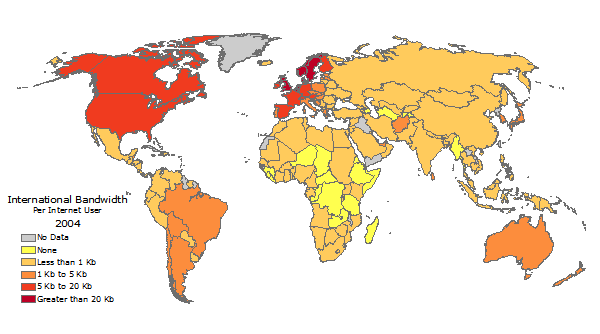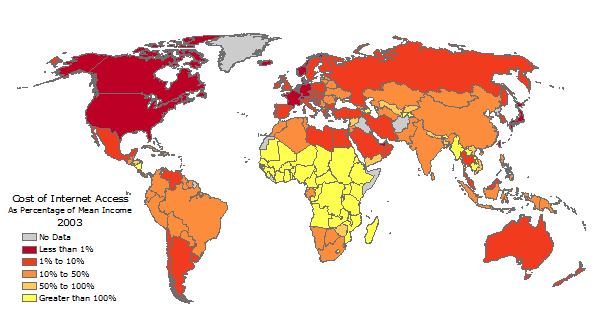Why Design your Website for Low Bandwidth?
Usability research has shown that the biggest factor in user satisfaction is speed of response. Optimising your website for response speed means people will enjoy using it more.
But it's more important than that. The number of Internet users in developing countries is estimated to have quadrupled between 2000 and 2005[1]. These users could access an increasing amount of valuable information.
Yet broadband connections are extremely expensive in the developing world. Most users cannot afford them, so have great difficulty using the many sites designed for high bandwidth connections. No matter how important its content, if a site takes too long to load it becomes unusable.

As broadband is becoming the norm in the developed world, website designers are forgetting the lessons of optimisation learned when the best you could hope was that your users would have a 56kbps modem dial-up connection. By allowing websites to grow bloated not only do we provide a poor user experience for all users, but we make our sites virtually unusable with a slow Internet connection.
We believe that optimised, efficient web design is important for global development and is a moral imperative. This is entirely achievable without compromising website design.
We have written guidelines[2] to help make optimising websites easier.
Why is Bandwidth Low in the Developing World?
Bandwidth is low because it is prohibitively expensive in developing countries. In 2004 low-income countries were paying more than ten times the price that high- and middle-income countries did for a broadband connection[1].

Currently (2007) some African universities are spending the equivalent of 20 full-time salaries for a 2000kbps Internet connection shared between 500-600 computers. This is expensive and slow for everyone[3]. These Internet connections can also be unreliable and subject to abuse[4]. As a result many users find the downloading of large documents impossible.
Section Links
Our Top Ten Tips list the most important things you can do to make your website accessible to users with low bandwidth connections.
The Design Guidelines describe those techniques in detail. Making a site low bandwidth friendly does not mean compromising its design - it can enhance usability for all users.
Our Tools page provides links to the most useful tools for website optimisation, including simulators, code optimisers and page analysers.
The Low Bandwidth Simulator[5] allows web designers to see how their site would be displayed over a low bandwidth connection.
Our Outsourcing guide gives suggestions to organisations on how to produce a tender document for a low bandwidth website.
References
[#1] Information and Communications for Development - Global Trends and Policies, World Bank, 2006. http://www.worldbank.org/ic4d
[#2] http://www.aptivate.org/webguidelines/Guidelines.html
[#3] African universities provide users with bandwidths of 30kbps - 500 to 600 times slower than at European and American universities. Appropriate Information-Communications Technologies for Developing Countries, Bulletin of the World Health Organization, Volume 85, Number 4, April 2007, 245-324. http://www.who.int/bulletin/volumes/85/4/07-041475/en/index.html
[#4] Optimising Internet Bandwidth in Developing Country Higher Education, INASP, 2003. http://www.inasp.info/file/361/optimising-internet-bandwidth-in-developing-country-higher-education-.html
[#5] Aptivate Low Bandwidth Simulator, http://www.loband.org/loband/simulator.jsp